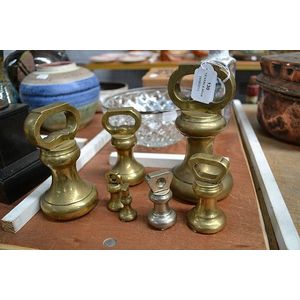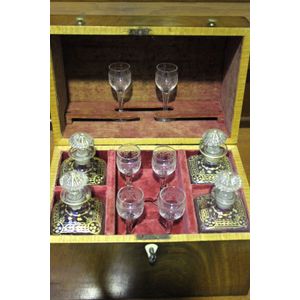Mahogany Liqueur Set with Gilded Bottles and Engraved Glasses
C1820 mahogany cased complete liqueur set with gilded bottles and engraved glasses
You must be a subscriber, and be logged in to view price and dealer details.
Subscribe Now to view actual auction price for this item
When you subscribe, you have the option of setting the currency in which to display prices to $Au, $US, $NZ or Stg.
This item has been sold, and the description, image and price are for reference purposes only.
- Mahogany - Mahogany is a dense, close grained red-coloured timber from the West Indies and Central America. It was first imported into Europe in the the early 18th century and its use continued through the 19th century. It was popular for furniture making because of its strength, the wide boards available, the distinctive grain on some boards, termed flame mahogany and the rich warm colour of the timber when it was polished.. The "flame" was produced where a limb grew out from the trunk of the tree, and this timber was usually sliced into veneers for feature panels on doors, backs and cornices.
Some terms used to describe mahogany relate to the country from which it originally came, such as "Cuban" mahogany, "Honduras" mahogany etc. However unless the wood has been tested the names assigned are more a selling feature, rather than a true indication of the timber's origin. - Gilding - Gilding is a method of ornamentation whereby a thin sheet of gold metal is applied to items made of wood, leather, ceramics, glass and silver for decorative purposes.
For furniture including mirrors, the sheet of gold is usually applied over a coating of gesso. Gesso is a mixture of plaster of Paris and gypsum mixed with water and then applied to the carved wooden frames of mirrors and picture frames as a base for applying the gold leaf. After numerous coats of gesso have been applied, allowed to dry and then sanded a coat of "bole", a usually red coloured mixture of clay and glue is brushed on and allowed to dry, after which the gold leaf is applied. Over time parts of the gilding will rub off so the base colour can be seen. In water gilding, this was generally a blue colour, while in oil gilding, the under layer was often yellow. In Victorian times, gilders frequently used red as a pigment beneath the gold leaf.
Metal was often gilded by a process known as fire gilding. Gold mixed with mercury was applied and heated, causing the mercury to evaporate, the long-term effect of which was to kill or disable the craftsman or woman from mercury poisoning. The pursuit of beauty has claimed many victims, not the least of which were the artists who made those pieces so highly sought after today.
This item has been included into following indexes:
Visually similar items

Set of six antique French graduating pewter lidded canisters, pewter baluster jug & large fish serving platter (8)
Sold by
in
for
You can display prices in $Au, $US, $NZ or Stg.

Set of antique brass bell weights (7)
Sold by
in
for
You can display prices in $Au, $US, $NZ or Stg.

Antique English jewellery box, brass bound, approx 11.5 cm high, 25 cm wide, 17.5 cm deep
Sold by
in
for
You can display prices in $Au, $US, $NZ or Stg.

Victorian Papier-mache stationery box, the outside is painted & inlaid with mother-of-pearl of scenes of ruins, the interior is fitted, 20.3 cm wide approx
Sold by
in
for
You can display prices in $Au, $US, $NZ or Stg.
